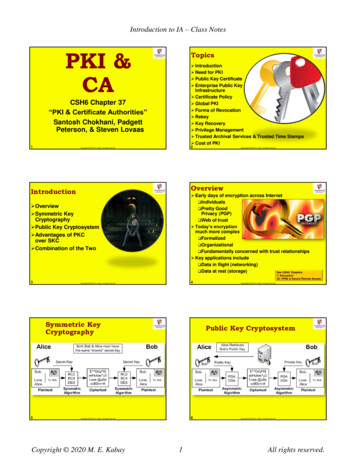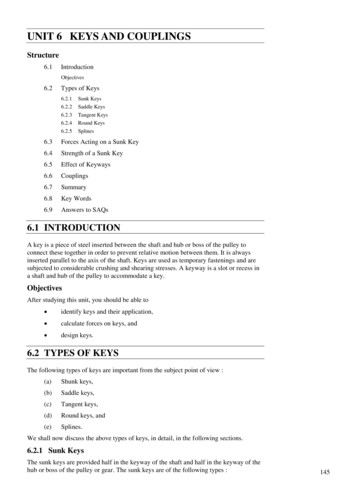
Transcription
The Ten Keys toBuilding Your Coaching BusinessBeyond the Next LevelSuzi Pomerantz, MT, MCCThis article first appeared in the International Journal of Coaching in Organizations, 2005, 3(4), 36-40. It canonly be reprinted and distributed with prior written permission from Professional CoachingPublications, Inc. (PCPI). Email John Lazar at john@ijco.info for such permission.Journal com2005ISSN 1553-3735 Copyright 2005 PCPI.All rights reserved worldwide.
The Ten Keys to Building Your Coaching BusinessBeyond the Next LevelSuzi Pomerantz, MT, MCCWhen you sit back and think about your business, what are the questions that you wrangle with the most? Are they questionsof expanding your business, of how to stay competitive in the market, of how to expand your operation to include yournetwork of colleagues into multi-coach interventions in organizations? As someone who conducts many workshops duringwhich coaches learn how to build their business, the author offers several enlightening answers to these important questions. Copyright 2005 PCPI. All rights reserved worldwideYou have been selling coaching services long enoughto know that there are natural, seasonal cycles to themarket and you’ve probably already found businessdevelopment systems to support you as you ride thewaves of that current. Maybe you’ve overcome thehurdle of building your business while billing time andsustaining the momentum of sales so that you canbalance your time between doing the work and gettingmore work. Perhaps you’ve mastered the use of theLessons Learned Meeting to cut your sales cycle time inhalf and expand the sale while serving the client. Nowyou want to define what is next for your business. Whereare you headed? Survival is no longer the goal, nowyou can focus on growth. Or not. What is the next levelfor you? What would represent a quantum leap beyondthe next level? Do you even want that?Whether you are an experienced coach who has built asustainable business grappling with questions aboutwhere you’d like to take your business next, or you areseeking a selling system for building your business, youwill need a systematic action plan that integrates threedistinct domains: networking, marketing and sales. Ofcourse, the first step is to strategically assess what thenext level of your business will look like. Do you knowwhat you want to do and what it will take to get there?Are you doing all you can to create the coachingopportunities you want? Do you have a concrete,systematic format for developing new business and newcoaching clients? Are you methodically implementinga strategic plan?Take a few minutes to explore the ten keys below to seewhere you might be able to perform a minor mindsetadjustment to tweak your business development effortsin a way that will get you what you want for yourbusiness and for yourself. None of these is rocketscience, or truly new information; however, you may36not have thought of them in the context of businessdevelopment before.1. How Big is Big Enough?To expand or not to expand? That is the question. If so,how? Stop to think about if your business is big enough.That means you have strategically created an entityseparate from your profession that has the capacity tohold the systems, people, strategies, financial goals,streams of income, and outreach methodologies thatwill attract and create the business that matches yourvalues, vision, purpose, goals, intentions and dreams.Does your business serve you while you serve yourclients? Are you leading your business, or is yourbusiness running you? If you trade your time for moneywithout additional streams of revenue, then you areself-employed, which is distinct from being a businessowner. Did you intentionally choose that? If so, and ithas been working for you, is it time to explore what itwould take to go from a self employed practitioner to abusiness owner?Business owners focus their strategies on systems andpeople: there are two ways to make money eitherpeople work for you or your money works for you. Tobuild a million dollar coaching business you need toleverage other people. Do you want to manage peopleand create systems or do you find that by remainingmore of a free-lance self-employed coach you have moreflexibility to create joint ventures and alliances andpartner with colleagues to expand your market offeringwithout having to build a business to do so? Do youdefine yourself as a practitioner, manager, entrepreneur,or all three? There are a few great resources that willguide this inquiry further: The E-Myth and The E-MythRevisited by Michael Gerber, Rich Dad, Poor Dad byRobert Kiyosaki, and the www.liveoutloud.com websitewhich has free downloads and free teleseminars that
An Open Forum (2005/Issue Four)support financial literacy and strategic businessbuilding.If you want to multiply your income, you will likelyneed to change what you are doing. The businessstrategy you choose will determine the size of thebusiness you can build, providing you have done thepre-work to clarify for yourself how big is big enoughfor you. Having said all that, I hereby give youpermission to not grow your business at all. It is okay toaccept that running your own coaching business maynot be the highest and best use of your personal coachingstrengths, and you might be better served to take aninternal position in an organization in which you canuse your coaching skills with your peers and employees.2. Building Business While Billing TimeWe are all familiar with the frustration of the cyclethat has us, as coaches, generate a full pipeline of leadsthat suddenly start to pop like popcorn, generatingbusiness that we then devote our time to delivering.While we are focused on client service anddeliverables, we often lose our focus and momentumon marketing and sales, thus resulting in thediscomfort of finding ourselves wrapping up projectsor client engagements with no further gigs on thehorizon and we must start all over again to build upthe business development bench strength. “But, I’mtoo busy to do any marketing or sales now I need tofocus on being billable, and the time I spend selling isnot billable time”. Does this sound like anyone youknow? In a systematic business development strategy,you can utilize two strategies that will allow you tocontinue to build business while billing time, thuscutting your overall sales cycle in half and expeditingyour acquisition of additional billable time whilereducing the amount of time you spend in-betweengigs.One strategy is the Lessons Learned Meeting as abusiness development tool, and the other is activelybuilding your business through referrals. The LessonsLearned Meeting is a structured interview with yourclients and key decision-makers in the organizationthat takes place in the middle of the engagement aswell as at the end. It is a time to check in with yourclients and learn from them what is working and whatcan be improved as well as a time to share with themwhat they can do better or differently to help you to doyour job better. Typically, these sessions are a mutualadmiration and acknowledgement fest, which is afabulous time to a) ask for testimonials, b) ask forreferrals, and c) ask what other challenges, issues,projects, or needs are coming up for your client so youcan shift the lessons learned conversation into a salesconversation. When interacting with your clients at37any point in time when they express gratitude orappreciation for your skill and contribution, you canask for referrals. There are three keys to getting referrals:1. Provide exceptional service.2. Express the importance of referrals to yourbusiness.3. Ask for referrals.Of course, once the referral becomes business, you closethe loop with a handwritten note or small gift to thereferral source.3. No One is On the BenchHow do you actively stay competitive in this rapidlyexpanding market? Networking and businessdevelopment are not spectator sports. Not only do youhave to be in the game, on the court, out in the field, butyou must think of everyone else in the world as alsobeing in the game with you. There are no benchwarmers,which means that none of your interactions with anyother human being is ever wasted. Every moment is anopportunity for building relationships, for speakingyour vision to everyone all the time. Another criticalpiece of this mindset is to operate from the assumptionthat everyone wants to help you. This assumption willallow you to make big, bold, outrageous requests thatwill encourage and invite people to contribute to yourgrowing business and blossoming self. If you are notnetworking all the time, what is in the way of that?Even if you spend most of your time with fellow coachingcolleagues, they can be great networking and businessdevelopment resources for you. Staying competitive inthe market may not actually be about competition.Let’s explore competition for a minute. In a personalservices business like coaching in organizations, eventhough you and all your would-be-competitors offersimilar or even the same services (360’s, MBTI,individual coaching, team coaching, situationalleadership, presentation skills, etc.), so much of whatyou do is unique to you as an individual, therefore doyou truly have competitors in your market? Here’s amindset that better serves coaches to expand our offeringinto organizations and be able to provide larger scaleinterventions than individual coaches: I’ve heard itreferred to as coopetition, an amalgam of cooperationand competition. The idea is one of collaboration withcompetitors, or turning competitors into partners bybuilding alliances and joint ventures as a businessdevelopment strategy. If you struggle with stayingcompetitive in the market, identify those you perceiveto be your biggest competitors and approach them tocreate coopetition arrangements that serve everyone andthe greater good of the client organization. It is the old
International Journal of Coaching in Organizationswin-win concept that we facilitate our clients toattain just applied to your own business growthstrategy.4. It’s a Numbers GameThere is a process to sales. In order to leverage thatprocess, it is important to understand the numbersinvolved. Typically, research shows that it takes tenphone calls to reach six people to set up one meeting. Ittakes ten meetings to get one client. That means that forsome folks, they would have to call 100 people to geteach client. If ten clients is considered a full schedule,that means 1000 phone calls. The sales process can takeanywhere from 5 minutes to 7 years, depending on yourcircumstances. Your personal hit rates may be quitedifferent from the general numbers mentioned here, butuntil you know and understand the numbers, it is veryeasy to get attached to specific outcomes, and to take itpersonally when you do not get clients. Persistence andresilience are part of this game. I’ve heard that 80% ofpeople stop trying to connect with a prospective clientafter their third attempt, however 80% of all sales aremade after the fifth attempt to connect!Recognizing that it is a numbers game will allow you tokeep your pipelines fully loaded, and to create the benchstrength you need to continually generate sales. Thegift in this numbers game is that it removes any of thosepesky attachment issues many of our colleagues face. Itis nearly impossible to be attached to the outcome ofsales if you have more leads than you can track! Sales isonly frustrating and emotional if we do not have enoughpossibilities in the pipeline, therefore we get attachedto needing each lead to become business. If you areactively pursuing five strong leads, you have time tothink about each one and to pine for it to work out inyour favor. If you are pursuing 150 leads, it becomesvery difficult to have high hopes pinned on any one ofthem, therefore freeing you up to focus on the salesprocess rather than specific potential opportunities.5. Scarcity to Abundance:Shifting Your Money ConversationWe could devote an entire issue of the journal to thistopic. Are you undervaluing your experience and underpricing your coaching services? Our executive clientstake us more seriously if we are priced in league withthem how credible are you if your hourly rate is morealong the lines of what their administrative staff earns?There is a scarcity mentality prevalent in ourprofessional community. This scarcity thinking leadsto coaches undervaluing themselves, their experience,and their education, which leads to under-pricingcoaching services.There are scarcity mindsets and coaching belief systemsembedded in our professional community and38propagated in our coach training schools that set upcoaches to not make money. One such approach is theconcept of giving away free coaching sessions to lure inclients. In reality, this method primarily allows thecoach to undervalue his services and to attract clientswho are more committed to getting something for freethan who truly value the coach and the service. Oncesomeone gets your services for free, it is very difficult totransition to paying high dollars for it. Do not diminishyourself or our profession by attaching a valuation ofzero to our work. You can make a huge contribution tothe world by providing pro bono services to those whocannot afford it, but giving it away for free as a salesploy is inauthentic and gimmicky. Offer a reducedintroductory rate, if you must, but stop giving away freesamples.I am continually amazed at the statistics I read aboutthe coaching profession that estimate that fewer than7% of coaches are making a living at it. Yet there are asmall percentage of sufficiently abundance andprosperity minded coaches who are generatingsustainable six figure revenues through coaching, andeven fewer who have successful business models suchthat they are doing multimillion dollar coachingbusinesses. Financial literacy1 coupled with abundancethinking can help coaches to shift the moneyconversation in our profession.6. Helping Professionsand the Conflict With SalesCoaches are not unlike the other helping professions.Self-employed doctors, lawyers, accountants, artists,and mental health professionals often sabotage theirown efforts to make a healthy living or amass personalwealth by not engaging in prosperity-generatingmindsets. Often, they are not aware of and are not taughtor trained in a systemic sales process, so they findthemselves truly committed to helping others andhoping that that will be sufficient to attract clients. Theyhave a helping mindset and are hoping for sales. Oftenthey have a negative view of sales and perceive it to beabout forcing oneself on others, or pushing people todo something they don’t want to do.Shifting to reframing their current sales mindset to oneof helping and meaningfulness would allow them tointegrate their commitment with sales activity. The otherthing I see a lot of is that people may be excellentpractitioners, but often they are not business people orsales people. To truly succeed in business, we must becoaches who think like business people and we mustconsider ourselves to be the sales executive in our ownbusinesses. If we think of sales as helping others todetermine if our services and products would be usefulto them or not, we can begin to integrate our commitmentto helping with our need to sell. Approach every sales
An Open Forum (2005/Issue Four)conversation seeking ways to help, with no pitches, noagendas, no attachments to closing. You can feel goodabout selling if it’s about making a difference withpeople, impacting leadership, or improvingorganizations in a global economy. Identify yourcurrent mindsets about sales and see how you canreframe sales to align with your values.7. Asking for What You WantClosing the deal becomes very simple almost a nonevent if you’ve been fully present in the conversation. Itis a matter of listening for the opportunity to ask forwhat you want. Yes, you have to actually ask for the“buy”. You have to ask your client to contract with you.You have to ask for the money. However, if you havebeen selling through your natural style, using a coachingapproach to sales, having an abundance mentality, anda helping mindset, then closing is as effortless as fallingoff a log. If you find that you have blocks when it comesto closing deals, then I’d refer you back to number 6above and suggest that producing for yourself a shift inyour money conversation will allow you to generate abreakthrough in asking for and getting what you want.The hardest part is knowing what you want. If youknow what you want, then take the risk to ask for it. Ifyou are not crystal clear about what you want, don’task for anything until you attain that clarity, becauseyou will only confuse yourself and cloud the energyflow.8. Think Big, Play BigOnce you’ve removed your blocks and left scarcitythinking behind, it is time to invent. Without theshackles of thinking small, what’s possible? Can youdouble your rates? Can you re-think your sales strategy?Can you transition to a new business model? If therestraints are off what do you really want? Do youhave a coaching practice or are you building a coachingbusiness? How big is a big enough business? Do youhave the right team around you to build something thatwill continue to support you, sustain your continuallearning and development, allow you to focus oncontinual improvement in the areas of customer serviceand product development? Are you working as muchor as little as you wish? Do you love all your clients? Ifyou could have anything in your coaching business,what would it be? What will it take to get there fromhere? What would it look like if your business surpassedeven your own wildest dreams?9. Harness the Sales ProcessKnowing that sales is a process, respecting the numbersinvolved, and increasing your awareness of your ownsales cycle will allow you to leverage the information inthis article to take your business to the next level. Inorder to truly harness the sales process there are threethings required:391. Work the system.2. Be in continual action.3. Understand the distinctions between networking,marketing and sales so that you can track your progressin all three areas.It takes activity in all three domains to produce dollars,clients, and business. Networking involves all the stepsyou take to meet people and begin to developrelationships. Marketing is all the stuff you docommunicate your credibility and service offering tothe world. Making calls, scheduling meetings with thosein your target list, and asking for the “buy” are salesactivities.10. Mailbox MoneyEventually, we get tired of selling our time for money.There is only so big you can grow your business thatway, because time is limited to 24 hours in a day andyou are limited in how many of those hours of each ofyour days you can sell. The answer is to find multiplestreams of coaching income, and multiple revenuesources outside of coaching as well. Perhaps you createproducts that leverage core content in a specific nichemarket, perhaps you catch the wave of the current trendto harness the internet to reach prospective clients andsell products. Perhaps you have secured an in-houseposition to utilize your coaching mastery, or you’vebranched into real estate or other investment strategiesto put your money to work for you.If you are not thinking about or doing anything togenerate passive income, that is – money that you earnthat is not directly linked to an exchange for your time,then you might consider one or more of these avenuesto take your business to the next level. How can youleverage those teleclasses you lead? Can you videotapeyourself next time you are in front of the room leading ameeting or training session? Can you find a colleagueto interview you on video or by telephone line that isthen recorded and put into an MP3 file that folks candownload from your website? Have you written a bookor been meaning to? Can you take the materials thatyou have created for various client engagements andlink them together somehow into a workbook ormonograph that you can sell? Do all your products andservices support a common vision, purpose, or set ofvalues that you stand for? Where are you notaccountable to yourself for what you and your businessstand for and how can diversifying your revenuestreams support that?No matter where you are in your coaching business,there will come a time when you wonder what’s next.Choosing which door to open next requires somereflection and inquiry. Often, the door we choose
International Journal of Coaching in Organizationsappears to be locked. We can momentarily see what’spossible, and then upon setting out to achieve it wefind obstacles and hurdles to overcome. Perhaps thekey to opening the locked door is one of the ten keysdescribed above? I invite you to engage in a dialogue,either in the forum of this journal or elsewhere in thecoaching world, to raise the level of financial literacyand business acumen of our profession such thatcoaching businesses continue to grow and thrive in theglobal market.Suzi Pomerantz, MT, MCCPhone: 301-601-1525Email: suzpomrntz@aol.comWebsite: www.innovativeleader.comSuzi Pomerantz is an executive coach and the CEO ofInnovative Leadership International LLC since 1993, awoman-owned executive coaching firm specializing inorganizational coaching, leadership development andbusiness development. Suzi has coached and trainedthousands of leaders and teams in over 107organizations internationally, including 11 law firms,helping leaders to clarify their vision and exceed priorperformance. She helps attorneys and coaches todemystify the sales process and implement a systematicprocess for business development. She helpsorganizations to improve communication andleadership, transforming cultures one individual at atime. Clients include corporations such as Tyco,DuPont, Lockheed Martin, Sears, Goldman Sachs,Pfizer, PriceWaterhouseCoopers, American ExpressFinancial Advisors, and many government agenciesand educational institutions.Endnote1Financial literacy is a booming coaching and training industry.Books by Robert Kiyosaki are a good resource, and you can learnmore at www. Liveoutloud.com to explore how one of ourcoaching colleagues. Loral Langemeier, has generated millionsby coaching people around the concepts of financial literacy.40From the Co-Executive Editor’s DeskBooks that John Lazar recommends anorganizational coach read . . .
Resource Center forProfessional Coaching in OrganizationsThe International Journal of Coaching in Organizations (IJCO) is the signature publication ofProfessional Coaching Publications, Inc. (PCPI). In addition to this internationally acclaimedjournal, PCPI publishes books on topics of interest to those in the coaching community, whetherpractitioner, decision maker, or end user. You can count on PCPI, Inc. to provide content thatpushes the envelope — bringing theory, research and application together in ways that inform,engage and provoke. Visit the PCPI website, www.pcpionline.com, to view and purchase ourgrowing line of products.If you have administrative questions, please refer them to our IJCO Office Manager, atofficemanager@ijco.info. For advertising, marketing and operations inquiries, please referthem to John Lazar, IJCO Co-Executive Editor, at john@ijco.info. Please submit unsolicitedmanuscripts for peer review consideration to the IJCO office manager at officemanager@ijco.info.Visit Both Our Sites at Your ConvenienceJournal com
services business like coaching in organizations, even though you and all your would-be-competitors offer similar or even the same services (360’s, MBTI, individual coaching, team coaching, situationa











